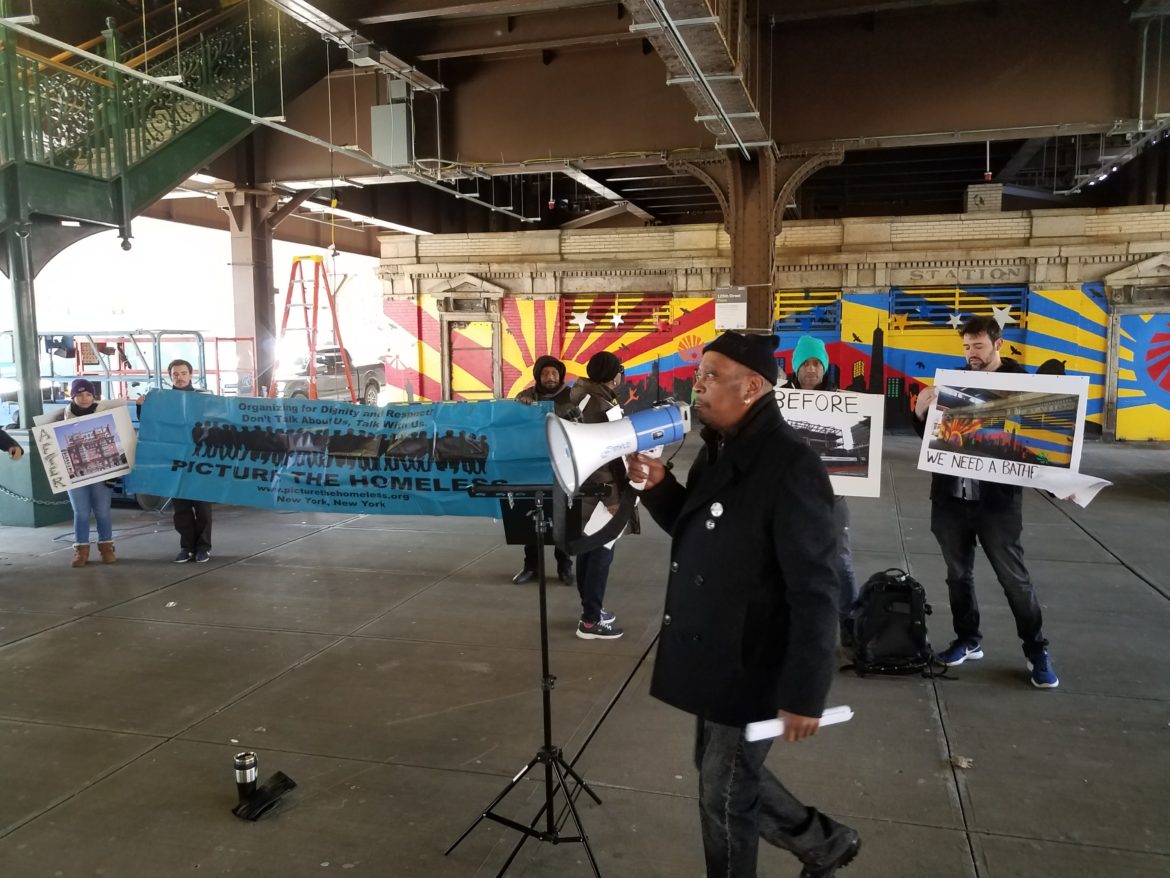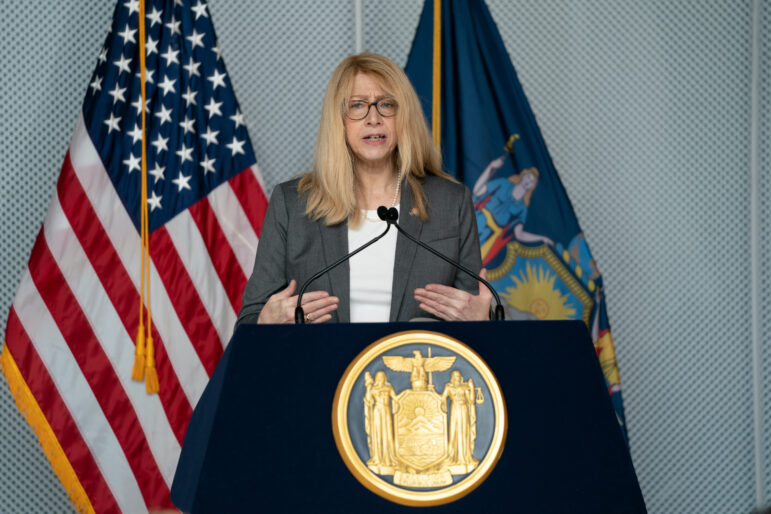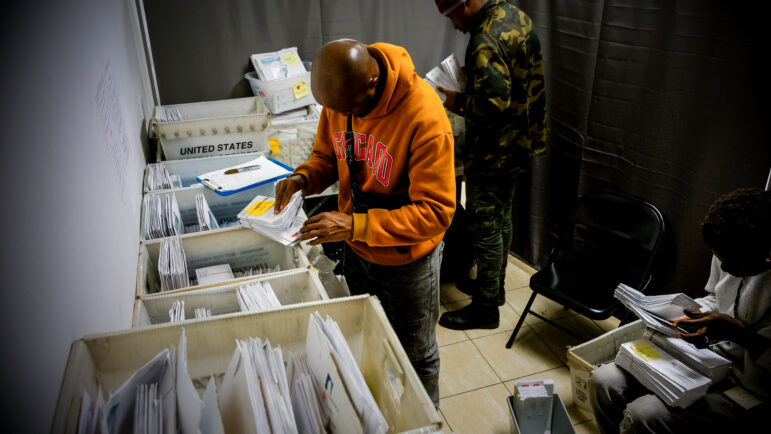
Murphy
Picture the Homeless members, led by the organization's civil rights organizer Nikita Price, take a stand for a place to take a leak.
When homelessness is the topic, the framework is normally night. We talk about how many shelter beds are being used. We distinguish between homeless people who have a place to lay their heads down and those who sleep on the street.
It’s an understandable emphasis, because there is something elemental about wanting everyone to be inside and safe when it’s dark and maybe cold. But homeless people are homeless during the day, too. Many work or go to school, but for those who don’t do those things—or who do them irregularly—it’s during the waking hours, when they might truly have no place to go.
In the summer, this means finding a way to beat the heat. In the winter, it requires managing the cold. But all year round, being out of doors during the day creates a basic human problem: Where do you go to the bathroom?
This is a problem that other New Yorkers—like, say, reporters working in the field, or parents toting a child who suddenly starts doing that tell-tale dance—face as well. Sometimes, if you’re willing to spend a couple bucks in a bar or store, you can get access to their john (a hopping child usually bolsters your case). But that path isn’t open to people without bucks to throw around. So, they go where they can, which can be humiliating, and result in a summons, and isn’t ideal for property owners and passers-by, either.
The area around the Metro-North station at 125th Street and Park Avenue and Harlem is an epicenter for this problem because many New Yorkers who are homeless gather there most days. It’s no surprise, then, that the area has been a hotbed of citation activity for public urination over the past few years, according to the group Picture the Homeless.
And while there is a tremendous amount of development activity in the area—there’s a new Shake Shack a couple blocks a way, there are active development sites on three of the corners near the station, and the recent East Harlem rezoning is remaking the broader neighborhood—one peculiar building sits dormant: A comfort station on the south side of the street under the railroad tracks. In other words, there’s a bathroom sitting idle in an area where people are often looking for a place to go.
Picture the Homeless is pushing for the city’s Department of Transportation to reopen that comfort station. Built in the 1890s by the New York Central Railroad, it was mothballed and handed over to the city when the successor Penn Central railroad went bankrupt in 1970, according to The New York Times. Until or unless the comfort station is reopened, PTH wants the city to install an Automated Public Toilet there. Its members say the bathrooms in the Metro North station across the street are off limits to them and that stores in the area don’t welcome those kinds of visits.
A DOT spokesman tells City Limits, “DOT is actively exploring placement of APTs that fit the siting criteria in the vicinity of the comfort station.” It is unclear what the timeline for that is, or whether opening the old comfort station is in the cards.
As you’ll hear in the audio mashup above, (featuring the voices of PTH civil rights organizer Nikita Price, PTG member Charmel Lucas and East Harlem Preservation founder Marina Ortiz) there is both a practical urgency and a symbolic weight to the push for a bathroom under the Metro-North tracks. The pace of change is accelerating in Harlem, with pricier stores popping up on the streetfronts and expensive housing rising to the sky. Amid that “progress,” PTH and its allies want to see something that’s for them, not for wealthier newcomers.
That a bathroom could take on that significance might seem silly. Until you really, really need one.









10 thoughts on “East Harlem Advocates’ Shocking Demand: Could We Use the Restroom?”
We have a similar issue in Sara Roosevelt Park on the Lower East Side and Chinatown. We pushed as a Coalition for decades to restore the Stanton parkhouse restrooms which has sat unused creating a derelict area though used for storage for all Manhattan parks. We get cars/trucks parking instead of active park space. We are advocating that the entire building be returned to the neighborhood for community use, resiliency center, emergency hub, recreational equipment depot (to distribute for ping pong, volleyball, etc) and that it have a homeless outreach desk. Two years ago our CM Chin and MBP Brewer gave the financing to restore the bathroom. Pragmatically speaking, in a park area that serves with a playground, spray shower, basketball and soccer players, elders, children – but also has a drug dealing problem – we also need our restrooms to be staffed and maintained to ensure safety, sanitary conditions and accessibility for all.
fyi: shelters do not “close up and kick them out” during the day. Sleeping dorms may be closed during the day but program and recreational spaces (and bathrooms) remain open and residents are welcome to stay at the shelter and use those spaces should they need or want to. Doesn’t solve the problem you outline above for those who leave during the day or those who live on the streets and, I definitely support access to restrooms for all but, spreading misinformation is not helpful to the cause.
Good note, Catherine — I’ve taken that phrase out of the story until I research it more.
They drink beer all day – morning until night. Why should my tax dollars pay for their bathroom because they choose to live that life? Stop advocating for those that choose to be homeless and find a new admirable cause.
Mike, tell us about your basis for saying that all homeless people choose to be homeless and that all homeless people drink beer all day. That is not the experience I have had in talking to homeless people. I’m curious to hear where your impressions come from.
This area is not a safe place for women. I take the M60 daily to school from this stop. I’ve seen multiple drug deals, men rolling cigarettes filled w/k2 and then vomiting all over the ground 10 feet from the bus stop. Men passed out on the sidewalk while metro north police walk by without giving them a glance. Men high out of their mind constantly brushing up against and asking for money. This area doesn’t need a bathroom. It needs the city to do its f—ing job, and give these poor men substance abuse and mental heath aid. It is a disgrace; NYC has failed its marginalized population.
I’ve never seen my city this way with so many homeless ppl, I think they need to reinforce some type of program to get these ppl off the streets. I wouldn’t want to walk around there with a child. It’s sad it’s degrading it’s a human dumpster💯
They need to bathe go to a shelter stop making It so easy for these people that’s the reason why nyc looks the way it does and we are the richest capital of the world that looks like a dumpster thanks to the people on the street. So it’s easy they want to bathe they need help on how to get back on there feet and they need to follow rules like everyone else . Open section 8 and give them apartments
I don’t know that providing a restroom is really “making it so easy” on these people. And I don’t know that, in “the richest capital of the world,” I’d blame the “people on the street” for why the city “looks like a dumpster.” But I’m probably weird that way.
I live in Harlem not to far from the Metro North Train.
The problem is a complex one. Creating Bathrooms will not fix the overall degradation of the area. Creating bathrooms will further worsen the problem. Bathroom areas will soon become areas for illegal activity, (drug dealing, drug usage, prostitution.) People need to stop sugar coating the mental disease that affect a good proportion of homeless society. The homeless people who want to get back on their feet are the ones who live in the shelters and work with the state to get a roof above their heads. The ones who smoke crack and drink liquor all day are the ones you see at 125 st by the Metro North train. We as a society have enabled them. Those people (the mentally sick) would have starved to death in most countries in the world. Not too long ago I walked past the 135 st and Lennox stop and i saw a homeless woman bent over urinating right by the stair well of the train station. Children see this type of nonsense daily. This is a major quality of life issue for the hard working tax payers. People work so hard to provide for themselves and their families and hardly anything is spend to improve our lives. Yet the state doles out billions to help those who choose not to be helped.